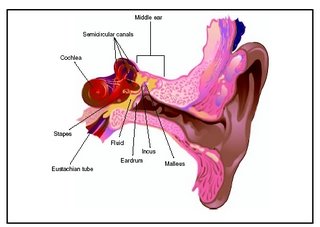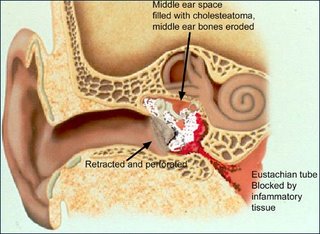| Some Stuff |
|
| Some MORE Stuff |
|
|
| Otitis media |
 This is an acute infection of the middle ear characterized by the presence of fluid coupled with inflammation. The middle ear is the second part of the ear where the eardrum and the three tiny bones called ossicles are located. When sound waves reach the middle ear, the eardrum vibrates and the vibration is amplified by the ossicles bringing them to the inner ear which translates these vibrations into electrical signals. Connecting the middle ear to the back of the throat is a small tube called the Eustachian tube. This tube serves to equalize the pressure between the middle ear and the outside. It also serves as drainage for fluid or mucus that gets into the middle ear. This is an acute infection of the middle ear characterized by the presence of fluid coupled with inflammation. The middle ear is the second part of the ear where the eardrum and the three tiny bones called ossicles are located. When sound waves reach the middle ear, the eardrum vibrates and the vibration is amplified by the ossicles bringing them to the inner ear which translates these vibrations into electrical signals. Connecting the middle ear to the back of the throat is a small tube called the Eustachian tube. This tube serves to equalize the pressure between the middle ear and the outside. It also serves as drainage for fluid or mucus that gets into the middle ear.
 How does the middle ear gets infected? This condition is usually noted after an upper respiratory tract infection whether viral or bacterial. The infection causes obstruction of the Eustachian tube allowing negative pressure to be generated inside the middle ear. This blockage will allow fluid to build up which is a fertile media for growth of microorganisms. This also entraps bacteria or virus that are already present inside due to the respiratory tract infection. If this infection remains untreated,this will cause rupture of the eardrum and/or extension of the infection to the inner ear structures. How does the middle ear gets infected? This condition is usually noted after an upper respiratory tract infection whether viral or bacterial. The infection causes obstruction of the Eustachian tube allowing negative pressure to be generated inside the middle ear. This blockage will allow fluid to build up which is a fertile media for growth of microorganisms. This also entraps bacteria or virus that are already present inside due to the respiratory tract infection. If this infection remains untreated,this will cause rupture of the eardrum and/or extension of the infection to the inner ear structures.
This condition is common in children because their Eustachian tube is narrower, shorter, and more horizontal. The most common symptom is pain on the affected ear because of fluid pushing on the eardrum accompanied by difficulty of hearing. There may or may not be fever. The condition becomes chronic if it lasts for more than 6 weeks. Four or more episodes in one year makes it a recurrent condition.
The condition is treated with antibiotics and analgesics. It must be differentiated with otitis media with effusion which is a condition characterized by presence of fluid in the middle ear but its not infected hence antibiotics are not necessary. |
|
|
|
|
|